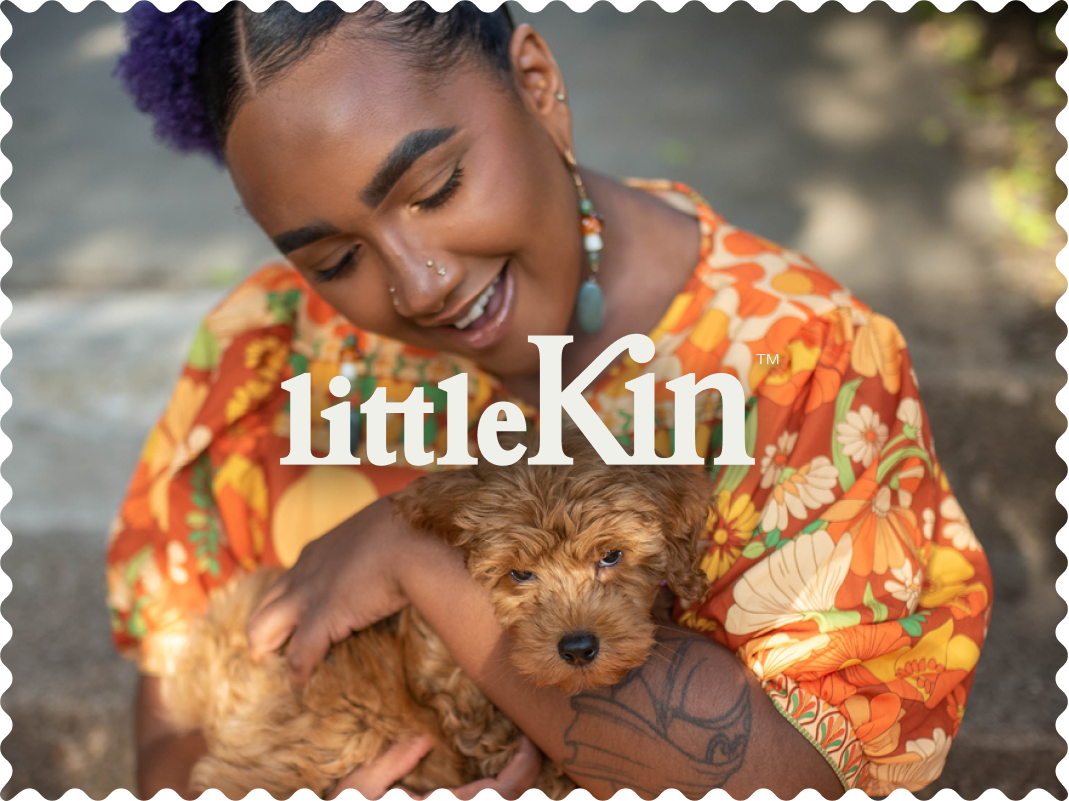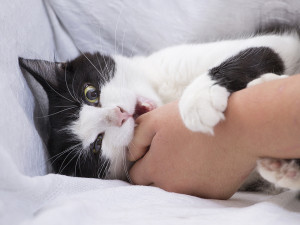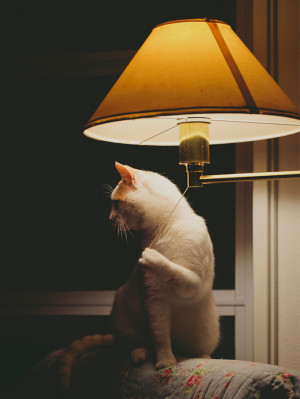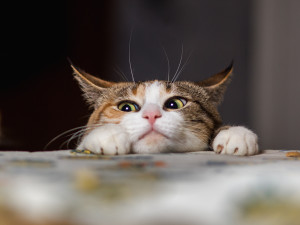
Share Article
In This Article:
Do All Cats Like Being Pet? Why Do Some Cats Like to Be Pet, But Not Others? Signs Your Cat Likes Being Pet Signs Your Cat Does Not Like Being Pet How to Tell If a Cat Wants You to Pet Them Where (And Where Not) to Pet Your Cat How to Pet a Cat Frequently Asked Questions
Somewhere between the 3 a.m. zoomies and the arrogant head flicks, cats have tricked humans into thinking they’re too cool for affection. But then — bam! — you’re chosen.
A warm, vibrating fur loaf lands in your lap and nudges your hand like it’s their divine right to be adored. But a minute later? Claws out, tail flick, betrayed glare. Loving a cat is like dating someone with a mood swing and a six-inch weapon at their fingertips.
So, do cats actually like being pet? The answer is yes, no, maybe, and “ask me again in 30 seconds.”
Cats are emotionally complex, highly individual, and prone to changing their minds without notice. Understanding whether your cat enjoys being touched (and how they prefer it) requires more than affection. It takes observation, respect, and occasionally, a bandage.
How much do you spend on your pet per year?

Do all cats like being pet?
Nope. While many cats enjoy physical affection, not all are into it. Some cats dislike petting altogether, some enjoy it in moderation, and others have strong preferences about how they want to be touched.
Breed, personality, early socialization, and even past trauma all play a role. A cat raised in a cuddly, human-focused home may be more inclined to seek physical affection, while one that was under-socialized as a kitten might view your hand as more of a threat than an invitation.
Even within the same breed, the difference can be huge. One Ragdoll might go limp in your arms like a plush toy. Another might go full “don’t touch me” if you try the same move. Rule of thumb? Don’t assume. Let the cat lead.
Why do some cats like to be pet, but not others?
Cats are wired for survival, not snuggles. In the wild, they don’t rely on others to groom or comfort them. So, when they allow a human to touch them, it’s a big deal. It’s a trust fall, except instead of falling, it’s leaning into your hand and exposing their softest, most vulnerable spots.
Whether your cat likes petting or not depends on:
Early socialization: Kittens handled gently between two and 9 weeks old are more likely to enjoy human contact later in life.
Temperament: Some cats are naturally calm and affectionate, while others are more aloof or high-strung.
History: Cats who have been rescued or formerly abused may associate touch with fear or pain.
Health: Cats in pain or discomfort might avoid being pet even if they used to love it.
Bottom line: it’s not personal. Some cats don’t like hands all up in their business. Respect that, and you’ll build better trust in the long run.
Signs your cat likes being pet
Petting a cat isn’t just about what you feel — it’s about reading the feedback they’re giving you. Look for these green lights:
Purring (though keep in mind some cats purr when stressed, too)
Head bunting (rubbing you with their forehead against you)
Slow blinking (the cat equivalent of “I trust you”)
Kneading with their paws
Relaxed posture, especially if they stretch out or roll to one side
Leaning into your hand or gently directing it
If your cat turns into a soft, purring puddle in your lap, congrats — you’ve hit the petting jackpot.
Signs your cat does not like being pet
Just because your cat isn’t running away doesn’t mean they’re having a good time. Watch for these clear warning signs:
Tail twitching or lashing
Skin rippling on their back
Ears flattening or swiveling sideways
Dilated pupils
Sudden grooming (a sign of stress)
Swatting, biting, or growling
Walking away or freezing in place
This isn’t them being “grumpy” — it’s how they communicate discomfort. Ignore these signals, and the following message might come with teeth.
How to tell if a cat wants you to pet them
Unlike dogs, cats don’t usually flop over and demand belly rubs. (And if they do, beware — it could be a trap.) Instead, a cat asking for attention will often:
Rub against your hand or leg
Nudge you with their head or cheek
Sit close and give you the “slow blink”
Roll onto their side (not their belly — don’t fall for it)
Meow softly or chirp
Let the cat make the first move. If they lean into your touch and stay relaxed, go ahead. If they back off or stiffen? Give them space.
Where (and where not) to pet your cat
Some spots are pure bliss for cats. Others are strictly off-limits unless you enjoy dramatic hissing fits. Safe bets include:
Under the chin
Behind the ears
Along the cheeks
Top of the head
Along the back (in short, slow strokes)
Proceed with caution or avoid these spots:
The belly (vulnerable territory)
The base of the tail (can be overstimulating)
Paws or legs (ticklish and sensitive)
Whiskers (they’re sensory tools, not for poking)
Some cats break all these rules and love a belly rub or tail scratch. But as always, let them show you what works.
How to pet a cat
Think of this as Cat Petting 101, a short course in feline diplomacy.
1. Hold out your hand
Palm down, fingers soft. You’re offering contact, not forcing it.
2. Wait for the cat to approach you
If they sniff, nudge, or rub on you, you’ve got the green light. If they walk away like you’ve offended them deeply, try again later.
3. Slowly and gently pet the cat
Start with slow strokes on the head or cheeks. Don’t rush. Cats like to savor their affection.
4. Watch for signs of discomfort
Tail twitching, skin rippling, or sudden stillness means it’s time to stop. Respect their boundaries. Petting should be a two-way street — less "grabby hands," more "respectful dance."
Bottom line
Many cats enjoy petting, but only on their own terms. Some tolerate it. A few want nothing to do with it. The trick is to respect each cat’s unique preferences and body language. When you do, you’ll earn trust that goes way deeper than physical touch.
According to Anita Kelsey, a certified feline behaviorist based in London, “The biggest challenge when living with cats that don’t like too much stroking is to recognize that not all cats like to be touched the way we think they do.”
If your cat is relaxed, purring, and seeking out your affection, go ahead and scratch that chin. You’re not just allowed; you’ve been invited.
FAQs
Do cats really enjoy being pet?
Many cats do, especially when the petting is on their terms and in the right spots.
What is the 3-3-3 rule for cats?
The 3-3-3 rule is a guideline for adopted cats: three days to decompress, three weeks to settle in, and three months to feel at home.
Do cats feel pleasure when you pet them?
Yes. Gentle, welcome petting releases endorphins and creates a sense of safety and comfort for most cats.
Are cats happier being the only pet?
It depends. Some cats thrive solo, while others enjoy a buddy, especially if appropriately introduced and given their own space.
References:
"How to Pet a Cat." PetMD, https://www.petmd.com/cat/general-health/how-to-pet-cat/opens in new tab
"How to Pet a Cat the Right Way, According to Experts." Daily Paws, https://www.dailypaws.com/how-to-pet-a-cat-7494235/opens in new tab
"How to Tell if a Cat Wants You to Pet Them." Class Act Cats, https://classactcats.com/blog/how-to-tell-if-a-cat-wants-you-to-pet-them/opens in new tab
Kelsey, Anita. "Low Petting Threshold in Cats." Cat Behaviourist, https://www.catbehaviourist.com/blog/low-petting-threshold-in-cats/opens in new tab
"Why Cats Like Being Pet." The Spruce Pets, https://www.thesprucepets.com/why-cats-like-being-pet-5191232/opens in new tab
"Why Do Cats Like to Be Petted? The Science Behind Feline Affection." Basepaws, https://basepaws.com/blog/why-do-cats-like-to-be-petted-the-science-behind-feline-affection/opens in new tab

Valerie Mellema
Valerie Mellema has a Bachelor of Science in Agribusiness and Equine Industry from West Texas A&M University. She has been a professional writer for the past 20 years, covering a wide variety of pet health and care topics before founding a nonprofit focused on mental health in children and thoroughbred aftercare. She has four Border Collies and eight retired racehorses.
Related articles
![White cat switching on lamp on couch]()
Why Does Your Cat Wake You Up at Night?
You want to sleep, your cat wants to party. Here’s how to deal.
![Cat grabbing onto ledge of table and looking to the left]()
Why Does My Cat Follow Me Everywhere?
Yes, they are right behind you.
Why Does My Cat Lick My Face?
It’s sweet, but a little much.
Why Do Cats Put Their Butt in Your Face?
Oh, hello.
Why Does Your Cat Lick Your Hair?
And should you let them?
Love Bite or Aggression? This Is Why Your Cat Licks Then Bites You
Cats can be such enigmas.








